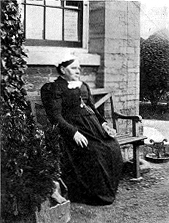|
|
A Month in an English Poorhouse,
Page 2 of 9
nearly a century ago, is of stone, and the passing of the years has colored it with the soft gray tones which time alone can give. Two long wings at the rear, three stories high, lead out from an octagonal central tower. In front of these, long, low wings surround two large courtyards, divided by the main hall of the building, the gable end of which fronts the street and forms the main entrance to the house. It had always been one of the cherished desires of my heart to sleep in a stone tower, into which I should ascend by winding flights of stone steps; and it was my lot to have my wish gratified in this English poorhouse, for my room was in the very top of the octagon, in shape like no other room in the world, I am convinced. I went up to it by three winding flights of stone stairs, over which so many feet had trod that many of the steps were worn deeply; it had even been necessary to repair them by setting in new pieces of stone. The walls of the house are covered in many places with masses of rich, green English ivy, while in others our own familiar Virginia creeper forms a blanket less thick but no less beautiful. The grounds and gardens which surround the house are exquisitely kept, and are so extensive that one can wander about the walks for hours. In front of the house, long, box-bordered beds are filled, as the season advances, with a succession of brilliant blossoms. When I first went up the broad, gravel walk, which leads from the street or, more properly, the country road, to the entrance, the whole place was gorgeous with the orange and gold of gillyflowers. A little later, roses held full sway; and later still, an army of pure white lilies, numbered by hundreds, marched in stately array down both sides of the long walk.
At the sides. and behind the house, the more material factors were considered. Huge beds of strawberries, patches of new potatoes, peas, beans, asparagus and lettuce were as carefully tended as the flowers. Many of the walks were bordered with lines of currant bushes, red, white and black, while carefully trained raspberry and gooseberry bushes were loaded down with fruit. In one corner, but by no means crowded, were the beds of mint, thyme, parsley and other savory herbs, which are considered such a necessary adjunct to every English kitchen. A hedge of apple trees, trained upon frames, in the set English fashion, together with some fine old box and yew trees, clipped for years into rigid shapes, add much to the picturesque beauty of the place. Behind the house a screen of trees makes a delicate green background for the gray walls of the old building. In front of it the ground slopes gently down to the valley of the river Nene, thence rising to a range of beautiful hills beyond. Just in the foreground stands a huge old stone windmill with wooden sails damaged by time, which still, however, gather strength enough when a strong wind blows to propel the antiquated corn-grinding machinery which yet remains inside. |
|
|
2
Books & articles appearing here are modified adaptations
from a private collection of vintage books & magazines. Reproduction of these pages is prohibited without written permission. © Laurel O'Donnell, 1996-2006.
|
||


